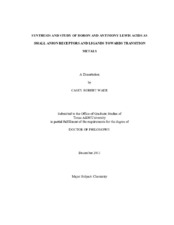| dc.description.abstract | Although fluoride is used at low concentrations in drinking water as a means of promoting dental health, it poses a danger at high exposure levels where it can lead to skeletal fluorosis or other adverse effects. Cyanide is notoriously toxic, and its large scale use in industrial processes warrants the need for close monitoring to remain aware of potential contamination of water sources and other environmental resources. Based on these considerations, it is critical to continue to develop improved methods of monitoring fluoride and cyanide concentrations in water. However, molecular recognition of these anions in water poses considerable challenges. For fluoride, this is due largely to its high hydration enthalpy (Ho = -504 kJ mol-1), which drastically reduces its reactivity in water. Additionally, the strong basicity of cyanide (pKa of (HCN) = 9.3) may obscure its detection in neutral water due to protonation. In addition to achieving detection of these anions in water, it is most desirable to have information of the detection event relayed in the form of a positive, rather than negative, response (i.e., turn-on vs turn-off).
The general strategy of appending cationic groups to triarylboranes imparts beneficial Coulombic, inductive, and sometimes chelate effects that have allowed a number of these Lewis acidic receptors to sense fluoride and cyanide in aqueous environments. With the goal of developing new triarylborane-based receptors that show enhanced affinities for these anions, as well as turn-on responses to detection, a series of pyridinium boranes were synthesized and studied. Having recognized that the inherent Lewis acidity of antimony(V) species might be exploited for anion sensing, we also describe initial studies on the ability of tetraorganostibonium ions (R4Sb+) and cationic transition metal-triarylstibine complexes (R3SbM+) to complex fluoride. Finally, the electropositivity of antimony and its ability to form stable compounds in both the +3 and +5 oxidation states have led us to begin investigations into the bonding and redox reactivity of novel metal stibine/stiborane complexes. | en |


